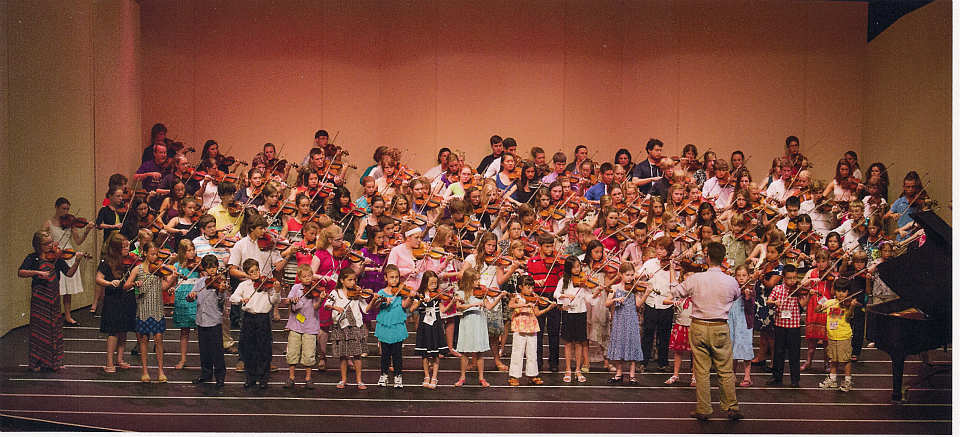The “Suzuki Method” is also known as “Talent Education”
“I want to make good citizens. If a child hears fine music from the day of his birth and learns to play it himself, he develops sensitivity, discipline, and endurance. He gets a beautiful heart.”
—Shin’ichi Suzuki

The Suzuki Method was conceived in the mid-20th century by Shin’ichi Suzuki, a Japanese violinist who desired to bring beauty to the lives of children of Japan after the devastation of World War II. As a skilled violinist but a beginner at the German language, Suzuki noticed that children pick up their native language quickly. He reasoned that if children have the skill to acquire their mother tongue, then they have the necessary ability to become proficient on a musical instrument. He pioneered the idea that pre-school age children could learn to play the violin if learning steps were small enough and if the instrument was scaled down to fit their body. He implemented his ideas and called it “Talent Education.” Suzuki believed that every child is capable of a high level of musical achievement. The goal of such musical education is to raise children with noble hearts, not principally to create prodigies.
Philosophy
…all children can be well educated…
—Shin’ichi Suzuki
The central belief of Suzuki, based on his language acquisition theories, is that all people can (and will) learn from their environment. The essential components of his method spring from the desire to create the “right environment” for learning music (he believed that this positive environment would also help to foster excellent character in every student). These components include:
- Saturation in the musical community, including attendance at local concerts of classical music, exposure to and friendship with other music students, and listening to music performed by “artists” (professional classical musicians of high caliber) in the home every day (starting before birth if possible).
- Deliberate avoidance of musical aptitude tests or “auditions” to begin music study. Just as every child is expected to learn their native language, Suzuki expected every child to be able to learn to play music well when they were surrounded with a musical environment from infancy. (This does not preclude auditions for public performances.)
- Emphasis on playing from a very young age, sometimes beginning formal instruction between the ages of 3 and 5 years old.
- Well trained teachers – trained in performance as well as in use of the Suzuki materials and philosophy. Suzuki Associations all over the world offer ongoing teacher-training programs to prospective and continuing Suzuki teachers. A basic competency as a performer is mandatory for all teachers in the American Association; a music degree is not necessarily required.
- Learning music by ear is emphasized over reading musical notation at first. This follows Suzuki’s observation that in language acquisition, a child learns to speak before learning to read. Similarly, memorization of solo repertoire is expected, even after a student is using sheet music to learn new pieces. There is no formal plan or prescribed materials for introducing music theory & reading into the curriculum; this is left to the judgment of the teacher.
- Regular playing in groups (including playing in unison) is essential in addition to individual playing. Typically students have a private and a group lesson every week.
- Retaining and reviewing all music ever learned, to raise technical and musical ability. Review pieces, along with “preview” excerpts of coming music, are often used in creative ways to take the place of traditional etude books. Etude books are not used in the beginning stages. The focus is almost exclusively on performance pieces and teaching points embedded within them.
- Frequent public performance, so that performing is natural and enjoyable.
The method discourages competitive attitudes between players, and advocates collaboration and mutual encouragement for those of every ability and level.
The parent of the young student is expected to supervise instrument practice every day (instead of leaving the child to practice alone between lessons) and to attend and take notes at every lesson so as to be able to coach the student effectively. It is not necessary for the parent to be able to play as well as the child (or at all); only that the parent knows from the lessons what the child should be doing and how the child should be doing it. This element of the method is so prominent that a newspaper article once dubbed it “The Mom-Centric Method” (Constance Meyer, LA TImes, Sept 7, 2003).